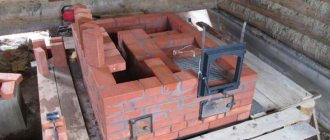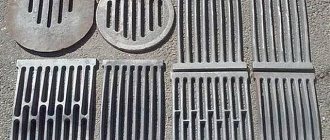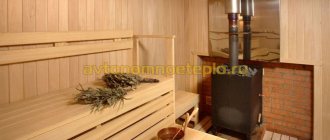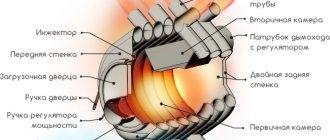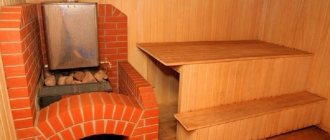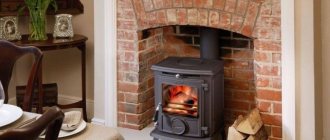A deck oven in a nutshell
Lately, more and more often, customers are asking us to make them
a deck oven .
I must say that this is a fad of literally recent years - somehow there was no talk about this before. And so: I want a hearth! Let's look into the details. First of all, let's define what a deck oven is. A hearth is a stove in which the firebox is devoid of an ash pan and a grate. In other words, in a deck oven, fuel burns in the same way as wood burns in a fire, or in a hearth. The fuel simply burns at the bottom of the combustion chamber, or just the firebox. The most striking example is the Russian stove. There is the bottom of a spacious firebox, or under, and logs are stacked on it. Or, here, the fireplace is the most, I think, familiar example to everyone. A fireplace is essentially a fire surrounded by stones. The wood burns like in a fire, the smoke along with the flue gases goes vertically into a chimney located above the fire - the simplest version of the combustion process. In other words, there may be indescribable beauty outside, but inside it is Paleolithic: the hearth of a caveman. And no science. This is essentially a fireplace, beloved by so many. This is in warm climates where there is enough radiant energy to provide warmth.
In Rus', things were different - the climate was different.
It’s difficult to say when exactly he became different, but it’s obvious that at the beginning it was also warm. And then it got colder. This is evidenced by the design of the Russian stove. When radiant heat became insufficient, a savvy Russian peasant decided to move the fire deeper: he moved the back wall of the fireplace, creating an additional combustion chamber. And before the smoke exited, he attached a cover - an obstacle to force the smoke to fall down, and leave some of the heat at the top, in the cap thus formed. of the deck oven appeared .
But gradually people figured out how to optimize this process as well. I came up with the idea of enhancing the natural combustion process by supplying additional air and removing non-combustible debris formed during the combustion process, which interferes with the full combustion of the fuel. In other words, he came up with an ash pit, a blower door and a grate , or grate .
It is believed that this happened with the advent of the steam engine and coal-fired locomotive, which needed a higher combustion temperature. However, I think that much earlier, since blacksmithing has existed since time immemorial, and in the forge hearth they use forced air injection, and the grate, together with the bellows, serves precisely to supply additional air to the fuel combustion area. But this is already a historical question. We understand the features of the firebox design.
So, the additional air supply was quite a serious step forward. Now the fuel could be burned under more optimal conditions. Moreover, through the grate not only air is supplied to the fuel from below, but also helps to remove the products of incomplete combustion down into the ash chamber, thereby increasing the supply of oxygen to the fuel. And this increases the intensity of combustion. As a result, it becomes possible to increase the combustion temperature, which means that the efficiency of fuel combustion increases: more energy is released and less soot is formed. And this is good: less fuel is needed for heating and more heat is generated!
The second consequence : the fuel combustion time is also shorter and, therefore, during the same time, more heat is released in the firebox than in a furnace that does not have an ash pit, that is, in a hearth . Why is it important? But because you can close the pipe earlier and leave more heat in the stove, and therefore in the room. Because while the pipe is open, heat literally flies out into it, and we drown the atmosphere. How to optimize the process?
Obviously, it is necessary to reduce the heating time of the furnace, but at the same time increase the combustion temperature. Then more heat will be released per unit time. This is exactly what the ash chamber and grate serve. The sooner we close the stove, the more heat will remain in the stove after closing the chimney. Therefore, the ash pan and grate are a useful invention. This, one might say, is a new stage in the development of stoves.
Grateless sauna stoves
A bathhouse is an area where people and buildings are exposed to high temperatures.
In order to correctly develop the design of a sauna stove that meets all standards, as well as the functional and aesthetic needs of consumers, you need a deep understanding of the processes occurring in the sauna stove and steam room, knowledge of the features of the stoves and their installation. Wood-burning sauna stoves from the Sukhovey plant of Feringer are developed on the basis of original design solutions aimed at improving the operational and consumer properties of the products: increasing service life, ease of installation and placement in the steam room, fuel efficiency, versatility and others. When developing stove designs, we take into account the volume of the steam room and adjacent rooms that require heating, the number of people simultaneously taking bath procedures, as well as the presence of a container for heating water or steaming a broom. Many years of experience of the best specialists of our company and an attentive approach to the wishes of customers help improve the designs of sauna stoves and expand their range. Our stoves for the Sukhovey bathhouse are environmentally friendly, hygienic, safe and have certificates of compliance with the requirements of the State Standard of Russia and fire safety. All this makes wood-burning stoves for the Sukhovey bathhouse ideal for connoisseurs and lovers of Russian bathhouses.
It is known that in wood-burning sauna stoves with a grate, air is supplied 10–15 times more than is necessary for the combustion process. Together with excess air, up to a third of the heat leaves the oven. In addition, unburnt fuel (a tenth of the total volume of firewood) falls into the grate holes. And these coals make up 99% of what we call ash. Therefore, every time after using the stove, it must be cleaned to empty the ash pan.
The grateless stoves for the Sukhovey bathhouse do not have all these disadvantages, therefore their efficiency is much higher than in stoves with a grate. The fuel in these stoves burns completely, and so little ash remains that the sauna stove has to be cleaned once every 15–20 burns. For example, in the traditional Russian bell stove, in which cabbage soup was cooked, bread was baked, and steamed, there was never a grate. They appeared when coal began to be used. A wood-burning sauna stove does not need a grate at all. In my own bathhouse I have been using a grateless stove for 3 years. Ash has to be removed only once every six months.
OPERATING DIAGRAM OF A GRITT OVEN
The air supply occurs through the ash pan and cannot ensure smooth adjustment of the combustion mode. The highest temperature is created in the grate zone, which leads to deformation and intense scaling of the grate, bottom and ash pan. The fuel lying on top creates a screen and prevents heat from spreading smoothly throughout the entire volume of the furnace. And excess air flow carries heat into the atmosphere. The tunnel area does not participate in the general air flow, so intense soot deposits on the door glass. After the first fire, the glass becomes opaque. Fuel loss ranges from 5% to 15%. All unburned fuel falls into the grate holes.
After each fire, the ash pan must be emptied
from the ash. However, not all the ash ends up in the ash pan—some of it remains in the firebox—so there is a need to clean the firebox itself.
OPERATING DIAGRAM OF A GATELESS OVEN
The air supply is smoothly regulated by a damper
and allows you to regulate the fuel combustion activity. the fuel burns completely, leaving only the salts contained in the wood, which make up 0.2% -0.3% of the mass of the firewood. ash plays the role of additional protection for the bottom of the sauna stove. Ash removal is carried out only once after 15–20 firings of the furnace.
The air supply through the damper at the top of the door protects the door and glass from overheating and prevents soot from settling on the glass.
The absence of a grate and ash pan allows you to change the shape and size of the firebox, thereby achieving the greatest efficiency of heat extraction.
Advantages of a grateless oven:
— fuel burns completely and evenly; — burnt fuel serves as additional protection for the bottom of the firebox; — using a damper you can smoothly regulate fuel combustion; — the air flow blows across the glass and prevents soot from settling on it; — cleaning the firebox from ash is done once after 15–20 firings of the furnace.
Without grate stoves for baths
Stoves for the home • Stoves for baths • Fireplaces • Heating • Installation St. Petersburg north: (812) 985-0625 | South: (812) 928-0111 | wholesale: (911) 926-0444
for the first time began producing hearth-burning stoves and fireplaces. Studies have shown that they are much more economical and environmentally friendly than grate-type ones. Air is supplied to them through the combustion door into the combustion chamber. Previously, this principle was used only in stationary brick and Russian kilns.
The main thing with “bottom combustion” is to thoroughly warm up the fuel combustion chamber. As a rule, there are two of them. However, models even with four cameras are presented. These are the ones we will talk about.
What is bottom combustion?
In this context, the term “bottom combustion” is considered only in relation to the combustion of large pieces of wood materials (firewood, briquettes), since for many other types of solid fuel (for example, sawdust, coal, etc.) this process is generally not feasible.
Unlike the traditional grate system, burning wood on a solid hearth (hearth or grateless) has its advantages. The main one is the so-called “top” combustion, when its front spreads from the upper layers of the fill to the lower ones as the fuel burns. In this case, the air supplied through the combustion door penetrates into the combustion zone in a quantity sufficient to completely oxidize the fuel, and the coals formed as a result of combustion heat the lower layers of the fuel and stimulate its thermal decomposition and the release of pyrolysis gases.
Provided the hearth and walls of the furnace are lined with heat-insulating material (for example, fireclay bricks), the latter accumulates heat from fuel combustion and maintains the high temperature in the furnace necessary to ensure an efficient combustion process (especially during loading).
Another advantage of deck ovens is that there is no need to regulate the air supply depending on the fuel combustion phase. During top combustion, the filling participates in the reaction only with its upper part and always contains layers of fuel at different stages of oxidation, i.e. The air demand is approximately constant over time and can be adjusted at a time. In grate furnaces, the entire stack is involved in the reaction, and the combustion phases change over time: in the initial phase (thermal decomposition and combustion of pyrolysis gases) more air is required than at the stage of coal combustion, and if adequate control of the air supply is not ensured during the combustion process , fuel combustion efficiency and furnace efficiency decrease sharply.
In conclusion, it should be noted that in hearth furnaces there are no grates as a structural element and consumable material, as well as the associated loss of fuel as a result of it falling into the ash box (approximately 5%).
Due to the reasons listed above, recently there has been a tendency to return to wood-burning fireboxes with a grateless (hearth) combustion scheme, especially taking into account the centuries-old experience and traditions of constructing classic Russian stoves.
Design features of heating and cooking grateless (hearth) stoves “Ligov”
1 – convector casing – shields thermal radiation and actively removes excess heat from the combustion chamber; 2 – furnace body; 3 – “direct stroke” valve – open during heating of the furnace; 4 – hearth-type combustion chamber; 5 – side combustion chambers; 6 – fireclay brick of the side combustion chambers; 7 – “under” – double row of fireclay bricks; 8 – reinforced rear wall made of ShA-94 brick; 9 – fireclay brick in the fourth combustion chamber; 10 – fourth combustion chamber; 11 – exit to the chimney.
Most heating furnaces operate in bottom combustion mode, i.e. They use a scheme for burning wood on a dead hearth. The base of the firebox and all side walls are made of fireproof and heat-intensive fireclay bricks; on top, the combustion chamber is limited by a thick 10mm cast iron plate with ring burners. The burners reduce thermal stress in the stove, allow the use of dishes with a spherical bottom for cooking, and also allow vertical loading of fuel. If the firebox height is at least 600mm, you can burn wood of the appropriate length.
In intensive combustion mode, the temperature on the surface of the stove reaches 420 0 C, while the brick walls, due to their heat-insulating properties, heat up to 700 0 C, guaranteeing stable combustion of fuel under any conditions (wet fuel, low atmospheric pressure, strong wind, etc. ). Despite such an intense thermal operating mode of the firebox, its service life with proper operation is virtually unlimited, since the operating temperatures of the materials used are far from critical (700 0 C for a cast iron slab and 1400 0 C for fireclay masonry).
1 – convector casing – shields thermal radiation and actively removes excess heat from the combustion chamber; 2 – furnace body; 3 – “direct stroke” valve – closed during bottom combustion; 4 – hearth-type combustion chamber; 5 – side combustion chambers; 6 – fireclay brick of the side combustion chambers; 7 – “under” – double row of fireclay bricks; 8 – reinforced rear wall made of ShA-94 brick; 9 – fireclay brick in the fourth combustion chamber; 10 – fourth combustion chamber; 11 – exit to the chimney.
Heating stoves "LIGOV" belong to the "bottom heating" stoves (when hot gases are first directed to the lower part of the stove) and have no analogues in their class in terms of design and length of gas ducts, combining the advantages of metal quick-heating stoves and heat-intensive brick stoves. The total length of the heat exchange path is more than 2 m. All gas ducts are limited on the outside by a heat-exchange metal shell, and on the inside by heat-intensive brickwork, which is washed by hot gases on both sides.
After lighting the stove, the heat flow through the metal wall heated to 250-350 0 C immediately enters the heated room (like a “potbelly stove”), while after the end of the fire the brickwork is heated to 500-700 0 C (85-150 kg in depending on the model) allows you to heat the room for 3-5 hours with the chimney damper closed (as in a heat-intensive stove).
Heating stoves "LIGOV" with a full load of fuel and limited air supply allow you to implement the "long burning" mode. During production tests, it was found that 10 kg of fuel briquettes burn completely in 14 hours to the state of ash, and after loading a new portion of fuel, it spontaneously ignites in a still hot firebox.
The lighting of LIGOV stoves is carried out in two stages:
– heating the chimney to create a stable draft due to the large length of the flue (produced using a “short stroke” by opening the damper in the upper part of the firebox for 5-10 minutes). – switching to heating mode by closing the damper.
In steady state, the temperature of the exhaust gases in the chimney does not exceed 160 0 C, i.e. The heat released during fuel combustion is almost completely utilized in the furnace volume.
Convection lining of "LIGOV" furnaces in metal or ceramic design provides reliable shielding of the hot shell of furnaces and allows you to create free or organized (at the customer's request) convection heat exchange in heated or adjacent rooms. The casing is quick-release and can be dismantled in a matter of seconds. At the same time, the heat exchange mode between the stove and the heated room changes from convection to radiant, turning the stove into a familiar “potbelly stove,” which is convenient for quickly warming up a cold room after a long break. As the furnace body warms up to 350 0 C, the casing can be easily hung back onto the mounting brackets. It is possible to combine both heat transfer modes by hanging the casing on only one side, if touching the hot furnace body during its operation is excluded.
Advantages of stove heating
Wood burning stoves heat up quickly and distribute heat over a long period of time. The brick emits radiant energy, which is good for health. A house where a stove is installed is always comfortable and warm. Thanks to draft, natural ventilation is created in the room. The designs often have a hob on which food can be prepared. In addition, such a stove can be used to dry clothes, shoes and food.
A combination oven is a device that has several functions. This includes a fireplace stove, a heating and cooking stove and a Russian stove.
The only significant drawback is poor heating of remote rooms. That is why they try to install the entire structure in the center of the house for uniform heat transfer. In large houses, it is advisable to install several stoves that have a combined chimney. The hob is usually installed towards the kitchen.
Heating equipment differs in appearance and design.
Usually the stove is installed between several adjacent rooms so that they all heat up evenly Source pechnoy.guru
Hearth and grate combustion in a fireplace and stove: what is the difference?
Top combustion is today considered in many European countries to be the most correct way of burning fuel. This is due to strict environmental requirements in Europe regarding emissions levels. A top-burning stove allows for cleaner exhaust from the chimney. The minimum CO emission is 0.17%, which is 4-5 times less than with grate combustion of fuel.
Hearth stoves are designed to be fired exclusively with wood. You cannot burn coal and peat in them.
The most beautiful combustion is in hearth fireplaces.
Main characteristics of the bottom combustion system:
· Firewood is placed on the solid floor of the firebox. The firebox does not have a grate and an ash box.
· The largest firewood is placed on the bottom of the firebox, densely; as the firebox is filled, the size of the firewood decreases and kindling material - wood chips, paper - is placed on the very top. They are ignited from above, air is supplied to the upper part of the firebox, combustion in this case occurs from top to bottom, the fuel burns more slowly, because Only the top layer burns, and not the entire mass, as with grate combustion.
· Firewood burns almost completely, because... temperatures inside the furnace are higher than with grate combustion.
· Primary air is supplied through the firebox door or through a specially constructed channel from the street or from a heated room. Air is supplied to the top of the fuel, rather than passing through its entire volume, this allows for “top combustion of the fuel.” Modern firebox doors (fireplace inserts) have special dampers to regulate the supply of primary air during the combustion process, this allows for high stove efficiency.
· The cold core (air duct under the grate) disappears from the oven.
· The bottom of the furnace is heated not only by flames (dust) but also by smoldering coals (heat).
· Ensures a low level of condensate in the chimney, because there is no initial “volley of water” into the pipe. Tar does not flow.
· Hearth stoves and fireplace inserts burn slowly. But once they have accelerated, they can produce high rates of wood burning. Thus, maximum heat is transferred to the inner surface of the furnace, heating it to the maximum value and creating the opportunity for slow cooling.
· It is convenient to cook and bake on the hearth. Bread ovens are usually hearth ovens.
Little Secrets
How to quickly ignite a hearth-burning stove: pour half a pile of finely chopped wood on top - it will give the initial heat. And then the lower ones, coarsely pinned, will give long-lasting warmth.
How to “recreate” repeated top ignition?... Throw wood onto the coals. If the stove is made correctly, then the flame should run upward on its own. And if the stove is not made correctly, then this must be achieved by stacking firewood and playing with the air supply.
There is no need to throw away any ash or coals - they provide air access. We lay firewood on top of them in a well and set fire to it on top.
How to make a burning stove from a barrel
If you nevertheless decide, having fulfilled all safety requirements, to get rid of vegetable waste yourself by burning, then for this purpose you can use different designs from a barrel.
How to make a barrel for burning garbage so that it functions as a furnace? For this you will need, of course, a metal barrel and a little engineering skills.
Let's consider several options for fairly simple designs made from barrels used as an oven for burning waste.
- A barrel without a bottom, mounted on bricks. First you need to prepare the site. To do this, pour sand with a layer thickness of approximately 10 - 15 cm onto a plot of land. Then you need to put a sheet of metal on the sand, on which the enclosing brick support is folded in the shape of the letter “P”. A grate should be placed on top of such a support. Then you need to install the barrel itself (after removing its bottom) on a brick base. This design of the barrel allows you to put dacha waste through the top, and ignite the fire below, in the brick fence. At the same time, it is easy and convenient to remove the resulting ash. When it rains, it is better to cover this structure with a lid.
- Barrel for burning waste with a drilled bottom. At the bottom of the barrel you need to drill a large number of holes (more than 10) to allow air to enter. For better oxygen penetration and for ash to fall out of the container, attach 4 metal support legs to the barrel. Install a metal grate inside at a height of 15 cm from the bottom of the barrel. At a distance of approximately 20 cm from the bottom, cut a hole in the container to serve as a blower. Attach metal loops to it and attach it again to the barrel so that you get a door with which you can add firewood and regulate the strength of the fire in the container. For convenience when transferring the structure to the barrel, handles can be welded. To protect from rain you need to use a cover.
The options considered are just some of the barrel designs used to burn accumulated plant waste. The creation of such stoves is limited only by your imagination, and, of course, by safety regulations.
About one of the fairly simple designs of barrel-stoves used for burning leaves, branches, dry grass, etc. at the dacha, they say in the next video
In addition, some craftsmen use barrels to create stoves for heating small spaces. Having at least a little knowledge of physics and the necessary tools, you can build, for example, a stove from a 200-liter barrel (standard volume), which is used to maintain heat in a garage or greenhouse.
Wood-burning sauna stove: how to choose
A person who decides to build a bathhouse will definitely be faced with the question of how to choose a stove and which model to prefer. There are enough characteristics to get confused. Therefore, we will try to systematize the main types and characteristics.
In order for a wood-burning heater to warm up a steam room well, retain heat for a long time and meet your requirements, it is important to know when purchasing it that the heat output of the stove must fully correspond to the volume of the steam room. Installing a wood-burning stove in a bathhouse that has low power and a large room volume will lead to the stove starting to overheat and function at the limit of its capabilities. Consequently, its service life will be significantly reduced, and bath procedures will take place at too low temperatures. If you take a stove that is too powerful than necessary, the room will overheat, which will lead to a reduction in the service life of the device. The finish will begin to crack, building and other materials will deteriorate. The oven will quickly break down when operating in such a confined space.
To calculate the required furnace power, first find out the volume of the steam room. To do this, you need to multiply its length, width and height. Without all the side factors, 1 kW of furnace power warms up a room volume of 1 m³. Further, if the room has non-insulated surfaces: windows, glass doors, ceramic tiles, or a brick wall, this must be taken into account when calculating. It is recommended to add each uninsulated square meter of the steam room to its total volume. Manufacturers usually indicate this in the furnace data sheet on how to make the calculation correctly. It is worth noting separately that when choosing wood-burning stoves, it is extremely important to purchase a unit that has a 20-30% power reserve.
Wood stoves can be closed or open
According to the location of the stones on the stove, they can be: with a closed heater (not ventilated) and with an open one (ventilated). In the first version, the stones are not visible; they are located in a niche, inside the stove itself. Such units are a very recent development of Finnish manufacturers. It makes it possible to maintain the temperature in the steam room for a longer period of time. In addition, such wood-burning stoves produce so-called “light”, that is, moist and soft steam at comfortably low air temperatures. In the second option, an open heater heats up the steam room faster and provides high temperatures in it, as well as low humidity parameters. The stones lie on top and water must be poured directly on them. It is not recommended to pour a lot of water onto hot stones, as the steam becomes very damp and worsens the microclimate in the steam room. With a closed heater, the steam is softer and more humid at a relatively low temperature in the steam room. Exposed stones create a higher temperature in the steam room with less humidity.
Wood-burning heaters also differ in the type of firebox, which can be remote or built-in
Remote. They are located separately from the stove in a room next to the steam room. Such placement makes it possible to reduce losses of thermal energy, simplify the process of supplying fuel and heat not only the steam room, but also other rooms in the bathhouse. Installation of a stove with a remote-type firebox in a wooden bathhouse must comply with all fire safety standards; therefore, a partition connecting to it is necessary Be sure to make it out of brick.
Built-in. An ideal option for a small bathhouse. This design ensures the concentration of the released thermal energy within the steam room, but you will also have to add firewood as you take bath procedures without leaving the room.
There are models of wood stoves equipped with a tank for preparing hot water. This is convenient when the steam room does not have hot water supply. The water tank also requires a choice, and this choice affects which stove is right for you. In addition to different volumes, the tanks differ in the method of connection to the furnace.
Chimney device
When it comes to heating equipment that runs on solid fuel, it is imperative to install a chimney. In this case, the chimney is made from a pipe with a diameter of 100 mm.
At a distance of 50–100 mm from the upper edge of the stove, a chimney pipe is cut in. This is a length of steel pipe into which the chimney will fit tightly. The smoke channel is made with a small horizontal section - 50 - 60 cm of a straight pipe is enough to weaken the draft. A large number of knees before leaving the premises is not allowed.
A chimney made of several sections is easy to use. This way you can clean it without any problems.
There are three types of water tanks
“Samovar” type tank. This is a tank on the chimney pipe. The chimney from the sauna stove passes through the water tank and the hot exhaust gases heat the water. This tank has a filler and drain hole. Typically, it is made of stainless steel.
Mounted tank. Such a tank is located close to or hangs on the furnace body. The water in it is heated by heat from the walls of the furnace body itself.
Remote tank. This is a separately hanging tank, which can even be in another room. It connects to the heat exchanger in the furnace and due to this, the water is heated. But for such a tank, to heat the water you need a special stove with a built-in heat exchanger. If you decide to choose a stove with a heat exchanger, it becomes possible to heat the steam room itself and adjacent rooms: dressing room, locker room, and other rooms
Conclusion
Perhaps these are the main points you need to know to design your own ash pit. Making a furnace ashtray is quite simple. Having information about the dimensions, necessary elements, components and materials, you can easily make this device at home.
Remember, before you make a stove with your own hands, make sure that it will be safe for you and others. A proper chimney and a well-made ash pan are the foundations of a good stove. Therefore, it is worth consulting with professionals, seeing what store-bought versions of stoves look like, and reading about the different types.
Having figured out what an ash pan is, what size it is and what it consists of, what materials are needed for it, what the construction instructions look like, what tool to use and how to clean it later, you can be calm about the correct construction of such a device.
Building a stove is a very labor-intensive process, so be patient and get to work!
The material from which the heater is made is of great importance.
Most heaters today have a steel or cast iron body. Wood-burning heater stoves made of heat-resistant chromium steel have proven themselves well. The chromium content in it is at least 15%. This stove is good because it does not burn oxygen in the room, thereby creating more comfortable conditions for steam procedures. Almost all industrial wood stoves have a multi-layer metal body. This prevents burns from accidental contact with the heater. This circumstance is especially important for small steam rooms, in which every free centimeter is worth its weight in gold. Models are also produced that are lined with natural stone or ceramic tiles. In this case, the stoves heat the rooms more evenly and remain comfortably warm. However, the cost of such cladding is quite high.
Pay attention to the volume of stones that the stove can accommodate. The more there are, the longer the heat in the steam room will last, which means the fuel consumption will be less. How to place stones in the oven and how many stones are needed is a purely individual matter. On average, you can calculate the number of stones based on the volume of the steam room - for each meter of volume you need approximately 20-30 kg of stones.
Choosing a sauna stove with or without a grate
In recent years, a persistent stereotype has developed that wood-burning stoves for baths must have a grate in their design. It arose when industrial metal heaters appeared and the grate bars needed in coal-fired steel or cast iron stoves were mechanically transferred to them. Of course, if the heater is heated with coal, this element is needed. However, in traditional wood-burning heaters, a grate was never made. If you are planning to buy a stove that will be fired exclusively with wood, you may well purchase a model that does not have a grate.
To fully steam, you must heat the heater correctly. The best fuel for a wood-burning stove for a sauna is birch logs, as well as wood from some other deciduous varieties. It is undesirable to use coniferous firewood, because the resins in which they are extremely rich contribute to the formation of soot during combustion. When you have no other choice, and you have to heat the heater with pine logs, throw a few aspen dies into the firebox at the end. The flame of this wood will burn out the fumes and soot in the stove.
Recommendations for carrying out construction activities
When constructing a stove with a hob and a water circuit, the following standards must be adhered to:
- The stove and nearby surfaces must be separated by a safe distance. For these purposes, a metal sheet is additionally installed in front of the firebox to protect the floor and partitions.
- To make the masonry as strong as possible, every 4th row of bricks is reinforced with metal pins.
- A clay mortar of medium plasticity is used as a mounting mixture. A small ball rolled from it should not crack or crumble when it hits the floor.
- The chimney must have a height of at least 5 m: the presence of a head is a prerequisite. This element is designed to protect the chimney from climatic precipitation and blockages. In addition, it helps to increase traction and decorate the building.
Building a home stove with a boiler with your own hands usually does not cause any particular difficulties. Quite often you can find metal structures that are not inferior to brick ones in terms of external aesthetics. Such a product can greatly decorate a home interior. For the construction of brick kilns, a special building material is selected. The best option is fired ceramic red bricks. They are distinguished by their uniform color and metallic sound when tapped.
Advantages and disadvantages of wood stoves
Wood-burning heaters have many fans. The first point is that nothing can compare with the peaceful and cozy crackling of wood in the stove, its unique smell and the magic of an open, living fire. A wood-burning sauna stove is preferred by those of us who value traditions and special kindling rituals.
As for the practical considerations that force you to choose such heaters, they are also present. When a steam room is built on an area where gas is not supplied, you have to choose between electricity and firewood. Electricity is much more expensive, firewood is quite affordable and can be prepared in reserve. Another important advantage is that a wood-burning heater makes it possible to quickly achieve the desired temperature in the room and maintain it for a long time. The disadvantages of such stoves include the fact that during bathing procedures it is necessary to regularly throw logs into the firebox so that the flame does not go out. In addition, in the process of burning wood, carbon monoxide and smoke are formed, and it becomes necessary to install a reliable exhaust chimney.
